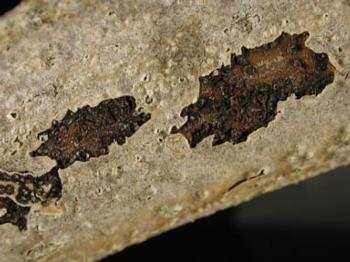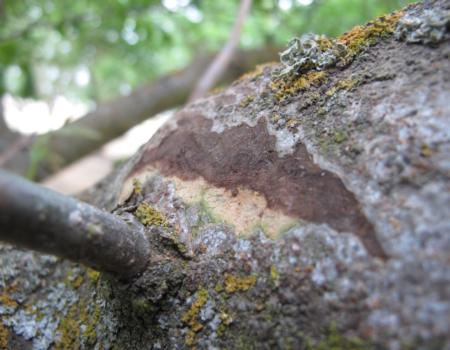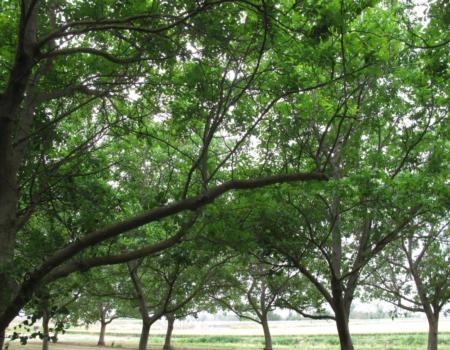Spring 2015: Bot fungi wreak havoc during drought
Regional Report Ventura County by Jim Downer
Nurseries growing woody plants often suffer with disease caused by Botryosphaeria and affiliated asexual stages of Botryosphaeria such as Fussicoccum, Neofussicoccum and Dothiorella (Bot fungi). These fungi are common in landscapes and wildlands and take advantage of drought-stressed plants. Bot fungi produce cankers and infect stems and branches with diameters from pencil sized up to many inches.
Bot fungi infect either as conidia from the asexual stages of the fungus (fig. 1) or as ascospores from the Botryosphaeria stages. These spores are universally produced in dead or dying tissues on diseased plants. Spores are splashed in water, wind borne, or moved in brush, clipping or trimmings of diseased plants. Ascospores and conidia germinate readily at 28 to 32oC (82 to 90oF) (Sutton 1990), suggesting that current warm conditions in California could signal the onset of a difficult year with this pathogen. Germinating spores can enter directly into stems through lenticels or through wounds made during pruning or other injuries.

Fig. 1. Black and white fruiting bodies of Bot fungi that produce asexual spores (conidia) on walnut. Photo: T. Michailides
The various Bot fungi cause cankers (fig. 2) and stem lesions on susceptible woody plants, and eventually girdle stems, resulting in foliage symptoms of yellowing to browning leaves and flagging or dead branches in shrubs and trees (fig. 3). Sometimes the tips of plants are affected, especially if plants are hedged or wounded repeatedly. Bot fungi seem to attack drought-stressed plants, producing large amounts of inoculum under drought conditions in the dead and dying portions of affected plants. Botryosphaeria dothidea is the most commonly observed species but there are about 200 species worldwide affecting thousands of hosts. Native shrubs such as ceanothus, mountain mahogany, and manzanita are preferred hosts, especially following or during drought (Brooks and Ferrin, 1994). Bot fungi also affect trees such as oak, alder, redwood, avocado, maple and apple, both in production and in landscapes, though this disease is typically more serious in landscape situations where trees are not irrigated.

Fig. 2. Canker margin of Botryosphaeria dieback on 'Chandler' walnut. Photo: J. Hasey.

Fig. 3. Botryosphaeria dieback on a 'Chandler' limb – Photo: J. Hasey
In nursery production, preventing drought stress by consistent irrigation helps to preclude infection by bot fungi but does not totally prevent it in very susceptible species. Rogueing out infested plant material or pruning out infected branches helps to reduce inoculum. On larger specimens, pruning out deadwood is essential to controlling the disease (Bush, 2015), as the fungus usually sporulates in deadwood. Fungicides are available for control of Bot fungi but labeling must be checked before application. Fludioxonil, carbendazim, fluazinam, tebuconazole, flusilazole, penconazole, procymidone, iprodione, myclobutanil, and pyraclostrobin have all been shown to be effective in controlling Botryosphaeria disease of grape (Pitt et al., 2012). Fungicides are best applied after pruning wounds are made to protect exposed tissues from the disease.
Jim Downer
Environmental Horticulture Advisor
UC Cooperative Extension Ventura County
669 County Square Drive, #100
Ventura, CA 93003-5401
(805) 645-1458 phone, (805) 645-1474 fax
ajdowner@ucanr.edu
http://ceventura.ucdavis.edu
References
Brooks FE, Ferrin DM. 1994. Branch dieback of southern California chaparral vegetation caused by Botryosphaeria dothidea.
Bush EA 2015. Botryosphaeria canker and dieback of trees and shrubs in the landscape. Publication 450-726. College of Agriculture and Life Sciences, Virginia Tech. Univ.
Pitt WM, Sosnowski MR, Huang R, Qiu Y, Stell CC, Savocchia S. 2012. Evaluation of fungicides for the management of Botryosphaeria canker of grapevines. Plant Disease 96: 1303-1308.
Sutton TB. 1990. White Rot. Compendium of Apple and Pear Diseases. A.L. Jones and H.S. Aldwinckle, eds. Amer. Phytopathological Soc., St. Paul, MN.












